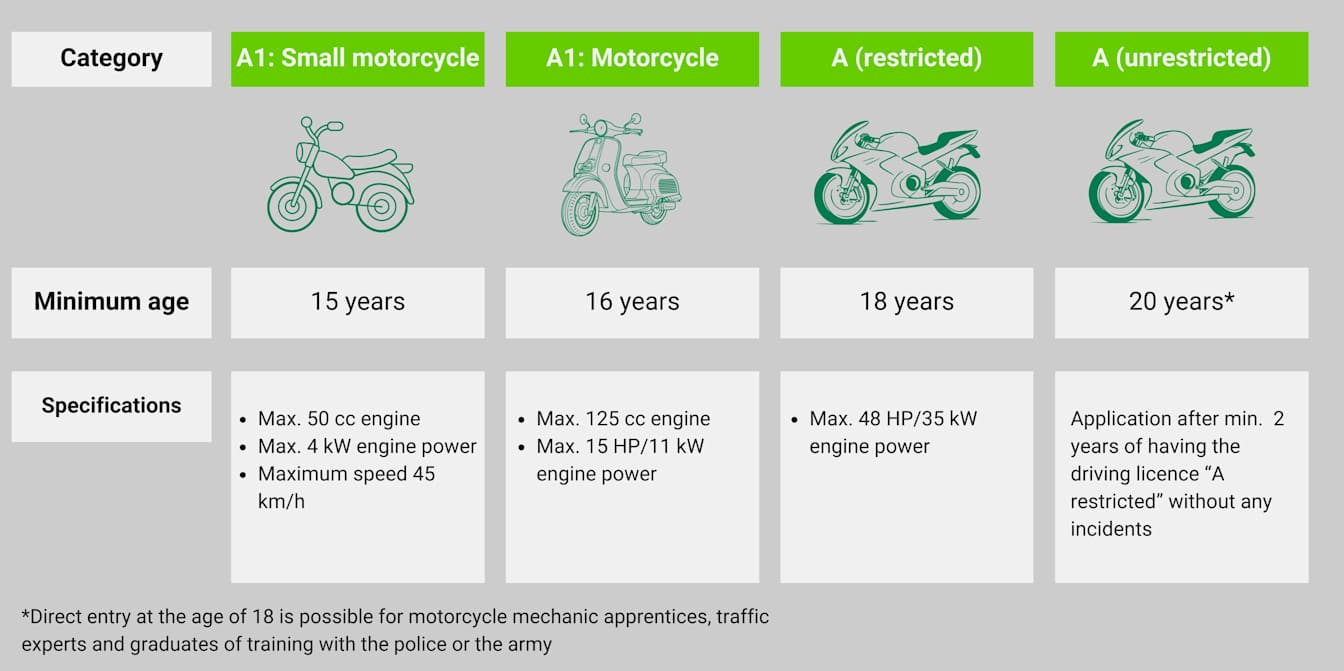Swiss motorcycle licence: what you need to know
What are the different categories of motorcycle licence? How much does a motorbike test cost? Comparis answers key questions.

19.11.2024

iStock/sukanya sitthikongsak
1. Motorcycle licence categories in Switzerland
In Switzerland, motorcycles are divided into four different categories. According to a legal amendment that came into force in 2021, the categories correspond to EU directives. Since then, people have been allowed to ride 125-class motorcycles (referring to the displacement) from the age of 16 years. In addition, with a few exceptions, it’s no longer possible to enter the “A unrestricted” category directly.
Motorcycle licence categories: an overview

Good to know: if you have a category A licence (restricted or unrestricted), you may also ride category A1 vehicles.
Application for an “A unrestricted” licence
After at least two years of riding experience without disqualification in the “A restricted” category, you can apply for a licence in the category “A unrestricted”. You must complete another practical examination including a manoeuvre test to qualify. If you pass, you may ride motorcycles without a restriction on the engine size.
Can I ride a motorcycle in Switzerland with a driving licence (B)?
No, you need a category A licence. If you have a category B or B1 driving licence, the path to qualify is easier depending on the motorcycle licence you want:
Category A1: you only have to complete the basic practical training.
Category A restricted: you must complete the basic practical training and the practical examination.
2. How to get your motorcycle licence in Switzerland
There are two phases to getting your motorcycle licence. The first is learning to ride the normal way, and the second consists of a compulsory additional training course while you have your licence on probation. Once you have completed the courses and passed the tests, they essentially remain valid indefinitely. The steps in detail:
Planning to apply for a provisional driving licence and register for the theory test? Then you must first complete a first-aid course. Here you can find a list of recognized course providers (not available in English).
You can skip this step if you have completed the first-aid course for another driving test within the last six years.
The result of the eye test is noted directly in the application form at the optician’s or ophthalmologist’s practice. The eye test may not be more than 24 months old.
To be allowed to drive with blue L plates, you must submit an application for your provisional licence to the residents’ registration office or road traffic office first.
This course lasts 12 hours for all category A licences. It must be completed within four months of getting your provisional licence.
Do you want an A1 licence and do you have a B or B1 driving licence? In that case, you’ll receive the definitive licence directly after completing the basic practical training. The three-year probationary period no longer applies.
The traffic awareness theory course is intended to give you a better understanding of road traffic at the theoretical level and to motivate you to drive carefully. You can skip this step if you have an A1, B or B1 driving licence.
In the practical test, you will have to prove your driving or riding skills. If you are applying for a category A licence rather than an A1 licence, you must also pass a manoeuvre test. This is carried out as part of the practical examination.
You can skip this step if you have a B or B1 driving licence and want an A1 licence.
After passing the test, you’ll get your probationary licence through the post. Important: a probationary period of three years applies. You won’t get your permanent licence until after the end of this probationary period, but you must apply for it and attend a compulsory one-day additional training course (“WAB” in German).
Do you already have an A1, B or B1 licence and would like to obtain an “A restricted” licence? Then you will receive the definitive licence directly after passing the exam, without any probationary period.
You must complete the further training course (“WAB” in German) within 12 months of receiving your provisional licence. You do not need to take another test. As of 2020, the WAB course lasts one day (seven hours).
You can skip this step if you have an A1, B or B1 licence.
Our tip: register for the WAB further training course immediately after passing your driving test. Time slots get booked up quickly. Anyone who does not complete the WAB further training course in the first 12 months will have to pay a fine of up to 300 francs if stopped by the police.
3. Swiss motorcycle licence: costs
The cost of obtaining a licence depends on the school, your needs and where you live. Set aside a minimum budget of about 1,500 francs – not including lessons. The costs are broken down as follows:
Approximate costs of a motorcycle licence
| Eye test | CHF 10–20 |
|---|---|
| First-aid course | CHF 100–200 |
| Provisional licence | CHF 20–80 |
| Theory test | CHF 30–40 |
| Traffic awareness theory course | CHF 200–280 |
| Basic motorcycle course | CHF 200–600 |
| Practical test | CHF 90–130 |
| Licence issue and delivery | CHF 30–50 |
| Additional training course | CHF 290–550 |
| Lessons | CHF 80–120 per lesson |
4. Additional costs of motorcycling
Protective clothing
Good basic motorcycle equipment includes a helmet, gloves, special boots, an all-in-one suit and a kidney belt. The law only requires that you wear a helmet, but depending on your canton you may need motorcycle-specific safety gear to take your test.
Motorway vignette sticker
Anyone using motorways and expressways in Switzerland must display a special sticker, called the vignette. This costs 40 francs. Find out the most important information about the Swiss motorway vignette here.
Liability insurance
Aside from servicing and fuel costs, motorbike insurance will often be one of the biggest expense items on your budget. As is also the case for driving a car, liability insurance is compulsory if you ride a motorcycle. This also applies to mopeds, such as a Vespa.
5. Swiss motorcycle licence: FAQs
That depends on the power of the electric motorcycle:
For electric motorcycles with a power output of up to 15hp or 11kW you need an A1 licence.
For electric motorcycles with a power output of up to 48hp or 35kW you need a category A licence.
For light mopeds (max. 20km/h) and mopeds (max. 25 km/h), you do not need a licence. Note that you still need to register these vehicles.
The practical motorcycle test takes about 45 minutes. The examiner assesses whether you are able to ride the motorcycle safely in traffic. The following manoeuvres are usually tested:
Parking the motorcycle and riding away
Riding on slippery surfaces
Riding in bends
Riding on the motorway
Riding up and down long gradients
The path to a motorcycle licence can vary from person to person. It depends on how quickly you gain practical experience and how many lessons you take.
While some people only need a few weeks, others can take up to a year to get their licence.
Don’t stress and set aside enough time for the necessary steps.
This article was first published on 02.04.2020





